Amaranthus are a fascinating plant, often thought to be an Australian native thanks to their vivid tropical hanging flowers that are naturally attractive to native pollinators.
However, they are in fact native to the Americas, and thrive in slightly wetter conditions than our own, so it’s important to find a good position in the garden. In our guide below we’ll share Amaranthus growing tips, as well as tips for how to grow amaranth for crops as well as ornamental plants.
More...
Genus: | Amaranthus |
|---|---|
Family: | Amaranthaceae |
Common Names: | Amaranth, Love Lies Bleeding, Pigweeds |
Location: | Outdoor |
Type: | Short-lived perennial |
Growth: | 3-8ft tall |
Sun requirements: | Best in full sun, but tolerates shade |
Foliage Colour: | Green |
Flower Colour: | Bright red |
Flowering: | Summer |
Fruit: | Edible seeds |
Maintenance level: | Low |
Poisonous for pets: | Non-toxic to cats and dogs |
What are Amaranthus?
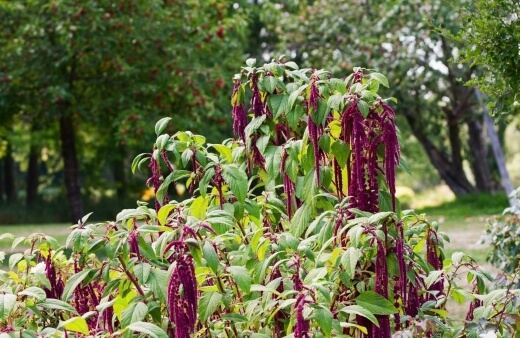
Amaranthus is a prehistoric plant, first thought to have been cultivated by the Aztecs thanks to its abundant grain production. Today, we grow amaranth as an ornamental perennial, and in cooler climates, it is often grown as a high-impact annual due to its ability to grow well over a metre per year.
Amaranthus is a genus that hybridises incredibly easily between species but is typically split into three subgenera; Acnida, Albersia and Amaranthus – though the difference between them is minimal and they do still hybridise.
Genetically speaking there are just two major subgenera of Amaranth; monoecious (plants with male AND female flowers) and dioecious (plants with just male OR female flowers).
While Amaranthus has hundreds, if not thousands of hybrids around the world there are only around 60 recognised species, all grown for their edible seeds and flowing waterfalls of bright flowers.
Natural Habitat of Amaranthus
Amaranthus are native to the Americas but likely spread west as continents separated, rather than evolving solely on that continent, and were later isolated by oceans.
Since the Aztecs, Amaranthus has been cultivated as a food crop throughout South America, and in warmer regions of North America, typically lasting three to four years as a productive crop in one location.
Amaranthus prefer full sun and are naturally adapted to infrequent but heavy rain. Despite this, they are usually quite happy to cope in dry, or shaded conditions, but not both.
For gardeners looking for easy, high-impact plants for the garden, Amaranth is a plant you really can’t go wrong with. Just don’t give it dry shade!
Is Amaranth edible?
Amaranth is an edible plant (which is why it is included in our list of edible flowers), with delicious leaves commonly used in South American cuisine as an alternative to spinach. Amaranth leaves have very little flavour, but the seeds have a slight nutty tone which is beautifully added to cereal, or toasted and sprinkled over a salad or in baking.
Amaranth stems are edible, but particularly stringy so it’s not advised to use them in cooking.
While amaranth seeds are high in carbohydrates, protein and vitamins, the leaves are a great source of fibre, and the entire plant can be juiced to produce a fibrous, protein-rich soup or an earthy drink which is often used in herbal medicine to ease digestive issues and excessive menstruation.
Best Amaranthus to Grow in Australia
1. Amaranthus hybridus ‘Opopeo’A. hybridus ‘Opopeo’ is grown both as a productive crop and an ornamental border plant. While they are annual plants, they readily self-seed, so should return to the same spot each year. They can grow as tall as 7ft. in full sun with plenty of water, and their magenta flowers add zest to any border design. | 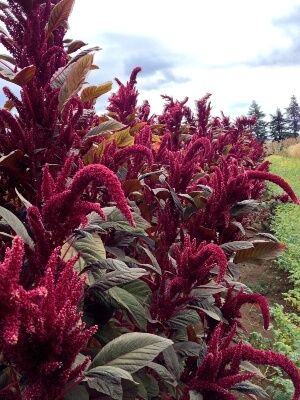 Source: uprisingorganics.com |
2. Amaranthus cruentus ‘Copperhead’I love the copperhead amaranths, with their warm, autumnal flower spikes that stand tall through summer and hold their structure well into fall before dropping seed. For any gardener trying to find russets and oranges for border groupings, these are the perfect backdrop to red and orange bedding or native annuals. A. cruentus ‘Copperhead’ usually grows to just under 5ft. |  |
3. Hopi Red Dye AmaranthAs the name suggests, pretty much everything about this Amaranth is dripping with red. The foliage, right through to the 6ft. tall flower heads are all bright, deep red, and the seedlings grow in such vivid colours that they are still used in dyes today for reliable colouring. | 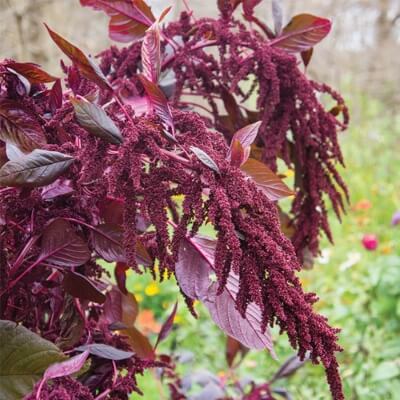 Source: selectseeds.com |
4. Amaranthus caudatus ‘Dreadlocks’I much prefer the upright amaranthus with towers of spiked flowers, but there’s something irresistible about the drooping habit of amaranth dreadlocks, which grows shorter than most, allowing it to be used as a border front plant, as the flowers cascade over edging from the 2-3ft. tall plants. |  Source: garden.org |
5. Amaranthus cruentus ‘Autumn’s Touch’Autumn’s touch grows to a fairly average 4ft. tall through one growing season and dies back completely, leaving masses of seed behind to regrow. Because Autumn touch is such a prolific self-seeder it will need some maintenance in spring to thin down seedlings as they emerge around the garden, but this is often reduced by native birds that adore the generous seed heads and will quickly strip their upright flowers when seeds ripen in autumn. | 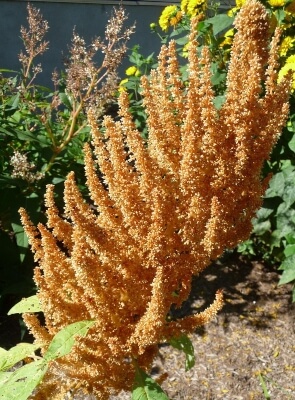 Source: garden.org |
6. Coral Fountain AmaranthCoral Fountain has gorgeous architectural stems that burst through the foliage as red flashes wrapped in grass-green leaves. If you’re scared of growing dogwood for its ability to spread, but with that same stem colour, these annual amaranths are much simpler to control and grow in similar conditions. While they prefer full sun, they will still grow to 2-3 feet tall in partial shade with enough water. | 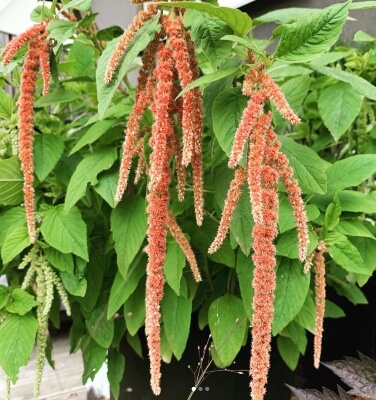 Source: gaiaorganics.ca |
7. Amaranthus cruentus ‘Hot Biscuits’The flower spikes on A. cruentus ‘Hot Biscuits’ are so reminiscent of Astilbe and False Goat’s Beard plants that they are often confused, even by professional gardeners, but there is a distinct difference in their foliage. The lighter, more open foliage of A. cruentus ‘Hot Biscuits’ allows them to cope with shade and sun in equal measure, though to get them flowering to 4ft. or more, they need plenty of water. | 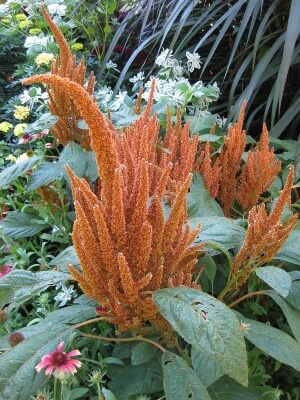 Source: ballaustralia.com |
8. Amaranthus tricolorWhile the flowers of this amaranth are gorgeous in themselves, it’s the foliage that truly stands out from this tricolour amaranth, Joseph’s coat. The variegated red, cream and green leaves are utterly spectacular in mid-late summer when the plants begin to reach their full height at 5ft, but even as seedlings, their new leaves are astonishingly vivid. |  Source: gardensonline.com.au |
9. Amaranthus hypochondriacus ‘Green Thumb’The green flowers on Amaranthus hypochondriacus make them ideal for woodland borders, or natural-looking planting. They don’t scream out at you from the end of the garden, but are utterly beautiful up close, with delicate green petals and more open seed heads. | 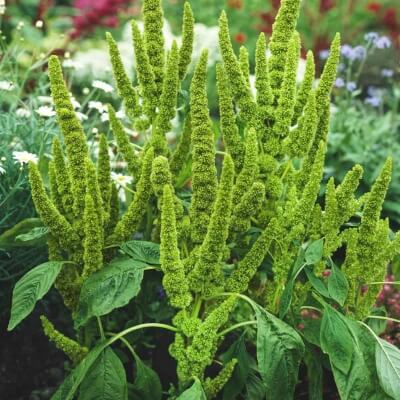 Source: outsidepride.com |
10. Amaranthus hypochondriacus ‘Pygmy Torch’At just 2ft tall in perfect conditions, the Pygmy Torch Amaranth is perfect for container displays. Pygmy Torch holds its own without overcrowding other plants around it and has a defiant structure to its deep red flower heads. | 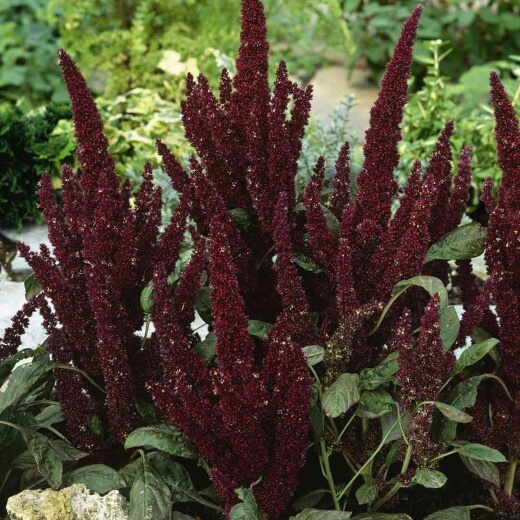 Source: outsidepride.com |
1. Amaranthus hybridus ‘Opopeo’

Source: uprisingorganics.com


Get Your Free Guide:
Master Growing Australian Natives eBook
A Must Have Complete Guide for Every Australian Garden
Get Your Free Guide:
Master Growing Australian Natives eBook
A Must Have Complete Guide for Every Australian Garden
A. hybridus ‘Opopeo’ is grown both as a productive crop and an ornamental border plant. While they are annual plants, they readily self-seed, so should return to the same spot each year.
They can grow as tall as 7ft. in full sun with plenty of water, and their magenta flowers add zest to any border design.
2. Amaranthus cruentus ‘Copperhead’

I love the copperhead amaranths, with their warm, autumnal flower spikes that stand tall through summer and hold their structure well into fall before dropping seed.
For any gardener trying to find russets and oranges for border groupings, these are the perfect backdrop to red and orange bedding or native annuals. A. cruentus ‘Copperhead’ usually grows to just under 5ft.
3. Hopi Red Dye Amaranth

Source: selectseeds.com
As the name suggests, pretty much everything about this Amaranth is dripping with red. The foliage, right through to the 6ft. tall flower heads are all bright, deep red, and the seedlings grow in such vivid colours that they are still used in dyes today for reliable colouring.
4. Amaranthus caudatus ‘Dreadlocks’

Source: garden.org
I much prefer the upright amaranthus with towers of spiked flowers, but there’s something irresistible about the drooping habit of amaranth dreadlocks, which grows shorter than most, allowing it to be used as a border front plant, as the flowers cascade over edging from the 2-3ft. tall plants.
5. Amaranthus cruentus ‘Autumn’s Touch’

Source: garden.org
Autumn’s touch grows to a fairly average 4ft. tall through one growing season and dies back completely, leaving masses of seed behind to regrow.
Because Autumn touch is such a prolific self-seeder it will need some maintenance in spring to thin down seedlings as they emerge around the garden, but this is often reduced by native birds that adore the generous seed heads and will quickly strip their upright flowers when seeds ripen in autumn.
6. Coral Fountain Amaranth

Source: gaiaorganics.ca
Coral Fountain has gorgeous architectural stems that burst through the foliage as red flashes wrapped in grass-green leaves.
If you’re scared of growing dogwood for its ability to spread, but with that same stem colour, these annual amaranths are much simpler to control and grow in similar conditions.
While they prefer full sun, they will still grow to 2-3 feet tall in partial shade with enough water.
7. Amaranthus cruentus ‘Hot Biscuits’

Source: ballaustralia.com
The flower spikes on A. cruentus ‘Hot Biscuits’ are so reminiscent of Astilbe and False Goat’s Beard plants that they are often confused, even by professional gardeners, but there is a distinct difference in their foliage.
The lighter, more open foliage of A. cruentus ‘Hot Biscuits’ allows them to cope with shade and sun in equal measure, though to get them flowering to 4ft. or more, they need plenty of water.
8. Amaranthus tricolor

Source: gardensonline.com.au
While the flowers of this amaranth are gorgeous in themselves, it’s the foliage that truly stands out from this tricolour amaranth, Joseph’s coat.
The variegated red, cream and green leaves are utterly spectacular in mid-late summer when the plants begin to reach their full height at 5ft, but even as seedlings, their new leaves are astonishingly vivid.
9. Amaranthus hypochondriacus ‘Green Thumb’

Source: outsidepride.com
The green flowers on Amaranthus hypochondriacus make them ideal for woodland borders, or natural-looking planting. They don’t scream out at you from the end of the garden, but are utterly beautiful up close, with delicate green petals and more open seed heads.
10. Amaranthus hypochondriacus ‘Pygmy Torch’

Source: outsidepride.com
At just 2ft tall in perfect conditions, the Pygmy Torch Amaranth is perfect for container displays. Pygmy Torch holds its own without overcrowding other plants around it and has a defiant structure to its deep red flower heads.
How to Grow Amaranthus
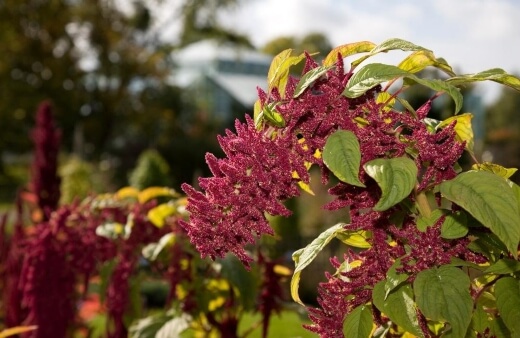
Amaranth is exceptionally easy to grow in Australia and has a similar visual impact to many native plants with drooping, tropical flowers that attract birds and pollinators into the garden.
Amaranth are often sold as plants for dry conditions or light shade, but it is incredibly important not to mix the two! Amaranth prefers sunny, moist soil with good drainage, and can cope with shade or drought, but never both.
Light Requirements
Amaranth grows best in bright, open fields, where they are grown on heavily cultivated soil treated with fertilisers and kept completely weed-free.
In those environments, where Amaranth is grown as a crop, the results are outstandingly beautiful, with drooping fields of red flowers and productive grain.
In our gardens, be sure to plant Amaranth in clumps in full sun if you can. Whatever water you give them, amaranth can become top-heavy, so growing in clumps protects lower leaves from drying out and the plants prop each other up against high winds.
Watering Amaranth
Amaranth are actually quite thirsty pants. If you grow them in containers they will need watering once a week. Growing in the soil, water them in summer when the soil dries out, but otherwise allow them to acclimatise to your conditions. They will flower well but in drier climates, you will get fewer seeds as a result.
Best Soil for Amaranthus
Amaranthus needs rich, well-drained soil. Throughout Australia, Amaranthus will return for three or four years until the plant exhausts its roots, after which you can either let it self-seed for new plants or save seeds and grow them indoors over winter for a better chance of new plants.
To help thrive as a perennial crop for as many years as possible, make sure to fertilise the soil well every year, and mulch them with at least 1-2” of compost in spring.
Amaranthus Propagation
Amaranthus can be grown from basal cuttings but it takes a lot of work and isn’t really worth the effort. By far the most reliable way to propagate them is to grow Amaranth from seed.
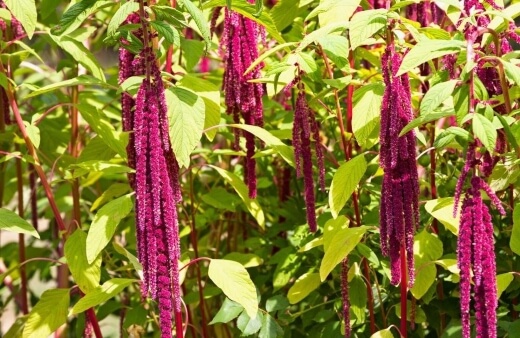
Planting Amaranthus from seed
Amaranth seeds are easy to germinate, and once you have one flowering plant you will have a lifetime’s supply of amaranth seeds to propagate from.
Tools:
- Seed module tray
- Seed compost
Method 1 (Sowing Amaranthus Indoors):
- Fill a seed module tray with compost, and sow a single seed in each module.
- Water well from the top.
- Leave for 7-14 days, watering only if the soil dries out.
- Germination should be near 100% successful.
- Allow them to develop roots and leaves in their modules until roots begin to form root balls and the seedlings are 3-4” tall.
- Plant directly into the garden
Method 2 (Direct Sowing Amaranthus):
- Prepare a patch of soil in the garden in early spring.
- Cultivate the earth down to a depth of 15cm
- Remove all weeds
- Mix in fresh compost (1:3, compost to soil)
- Rake over & dampen
- Scatter amaranth seeds thinly over the soil.
- After 7-14 days, germination should be visible.
- Thin seedlings to 1 plant every 15cm.
- Keep them watered, and watch them grow.
Tip: If you have a few different Amaranthus in your garden, try cross-pollinating them when their flowers open. Amaranthus are easy to hybridise, so choose two varieties with qualities you like, and as soon as the flowers open, brush pollen between them with a fine paintbrush.
Tie ribbon around the pollinated flower head, and use those seeds to grow next year. The results will be mixed, but you’ll have something unique!
Common Amaranthus Pests and Diseases
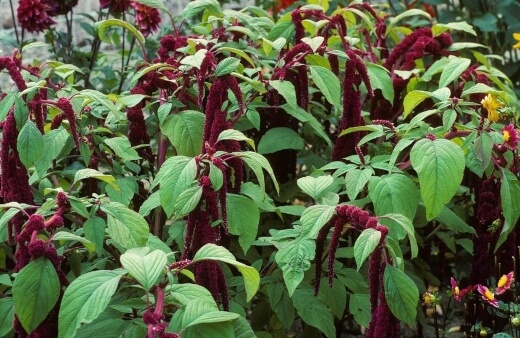
Amaranthus are quite susceptible to fungal diseases, even in Australia, but there is one very simple preventive measure for most diseases: don’t overwater.
Amaranthus hate having wet leaves, so only ever water at the base, and avoid wetting their foliage. Wetting foliage can lead to fungal infection, and also make a more attractive home for insects.
There are only a handful of specific pests, as well as common garden pests like slugs and aphids, that really cause serious damage to amaranths.
For slugs and aphids, use regular controls like spraying with a hose to remove colonising insects, or eggshells to deter slugs. The other pests include:
- Leaf miners
- Flea beetles
- Cutworms
- Leaf rollers
Leaf miners
Leaf miners are easy to spot and easy to remove. If you see contorted patterns across leaves, usually with white edges, this is the work of leaf miner larvae.
The red or white larvae are usually inside the leaf, or on the underside and should simply be disposed of in the bin along with the affected leaf.
A leaf that has been eaten by a leaf miner won’t recover, but the damage is unlikely to spread if you remove all affected growth, and keep an eye on the plant for the next two weeks to remove any fresh damage.
Flea beetles
Flea beetles are particularly attracted to brassicas, so avoid growing Amaranthus near cabbage, kale or sprouts. The damage done by flea beetles is rarely a cause for concern, but if you later water the leaves of Amaranthus, fungal infection can take hold in the wounds created by the beetles.
If the damage is excessive, remove any badly affected growth, treat the plant with an organic pesticide, and follow up with a diluted tomato feed at the base. This usually helps the leaves recover well.
Cutworms
Cutworms are unlikely on Amaranthus in Australia but have been known to damage crops. Cutworms are not actually worms, but caterpillars, laid by Noctuid moths.
These clever but frustrating caterpillars are hard to spot, as they spend the day underground and crawl up plants for a feast in the evening. To get rid of cutworms, just go into the garden with a torch and remove them at night.
Move them to another part of the garden as they won’t find their way back and usually stick to whatever foliage is nearby.
Leaf rollers
Leaf rollers or leafroller caterpillars are frustrating amaranth pests, but, if I’m honest, I think they’re kind of cute. As the name suggests, leaf roller caterpillars literally roll up living leaves of soft leaves plants (usual annuals) to create a cosy nest where they can hide, and later develop into moths.
Obviously, this isn’t great for your plants, but it’s a beautiful bit of nature at work, and rarely does significant damage to Amaranths.

Anthracnose (Colletotrichum gloeosporioides)
Anthracnose is a fungal infection that causes dark lesions on leaves. Anthracnose spreads through moisture and is often transported by insects. Avoid damaging leaves as this is where the spores enter and take hold of the plant.
If you notice these dark lesions near the base of a leaf, remove the leaf and the petiole to avoid it spreading through contact with other leaves.
Damping-off (Rhizoctonia spp. or Pythium spp.)
Damping-off is when seeds fail to germinate fully. Young seedlings will appear completely healthy but later flop and fail to recover. This is caused directly by wet soil.
Consider that seedlings are young plants with tiny root systems. Those root systems need minimal water to grow and develop so overwatering creates the perfect habitat for water to stagnate and support the development of funguses like Rhizoctonia spp. or Pythium spp.
Wet rot (Choanephora rot or Choanephora cucurbitarum)
Wet rot can occur on roots, or along the stem, and literally looks like mould, with pale hairy growths which are actually fungal spores growing bigger and bigger hand to high humidity.
To prevent wet rot, plant about 1ft apart, and thin out seedlings as they grow, leaving only the strongest. This creates aeration, but still allows plants to support each other against the wind.
Amaranthus Frequently Asked Questions
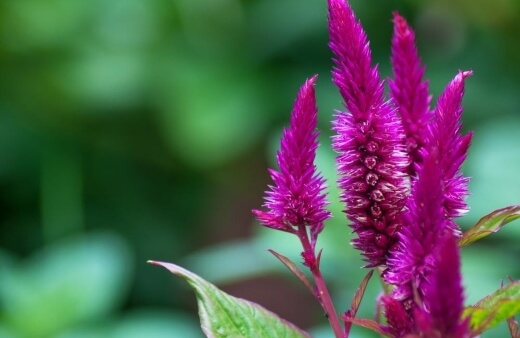
Is Amaranthus easy to grow?
Amaranthus is very easy to grow, preferring a bright sunny spot with well-drained soil. In severe drought, water them well to avoid wilt, but otherwise, Amaranthus are a very easy perennial flower that will return to your garden for around 4 years before you need to re-sow.
How long does it take to grow amaranth?
Amaranth are fast-growing plants that can go from seed to crops in less than four months, typically producing their first batch of seeds in around 3 months.
For best results with these unusual grain crops, sow them in early spring, and keep them moist but not soaking in full sun. As plants mature they develop more and more flower heads, so regularly deadhead them for more flowers.
Can you eat raw amaranth leaves?
Amaranth leaves are great raw and cooked, either in salads, or mixed into rice. They are much more fibrous than spinach or other similar crops but do have quite a stringy texture when eaten raw.
Are amaranth invasive?
Amaranth is typically easy to control, but in the right conditions can be a very prolific self-seeder. Because of its ability to self-seed in warm climates, it is often considered a weed in urban areas.
Thankfully, Australian winters make it harder for amaranth seeds to spread as efficiently as the damper American winters it is used to.
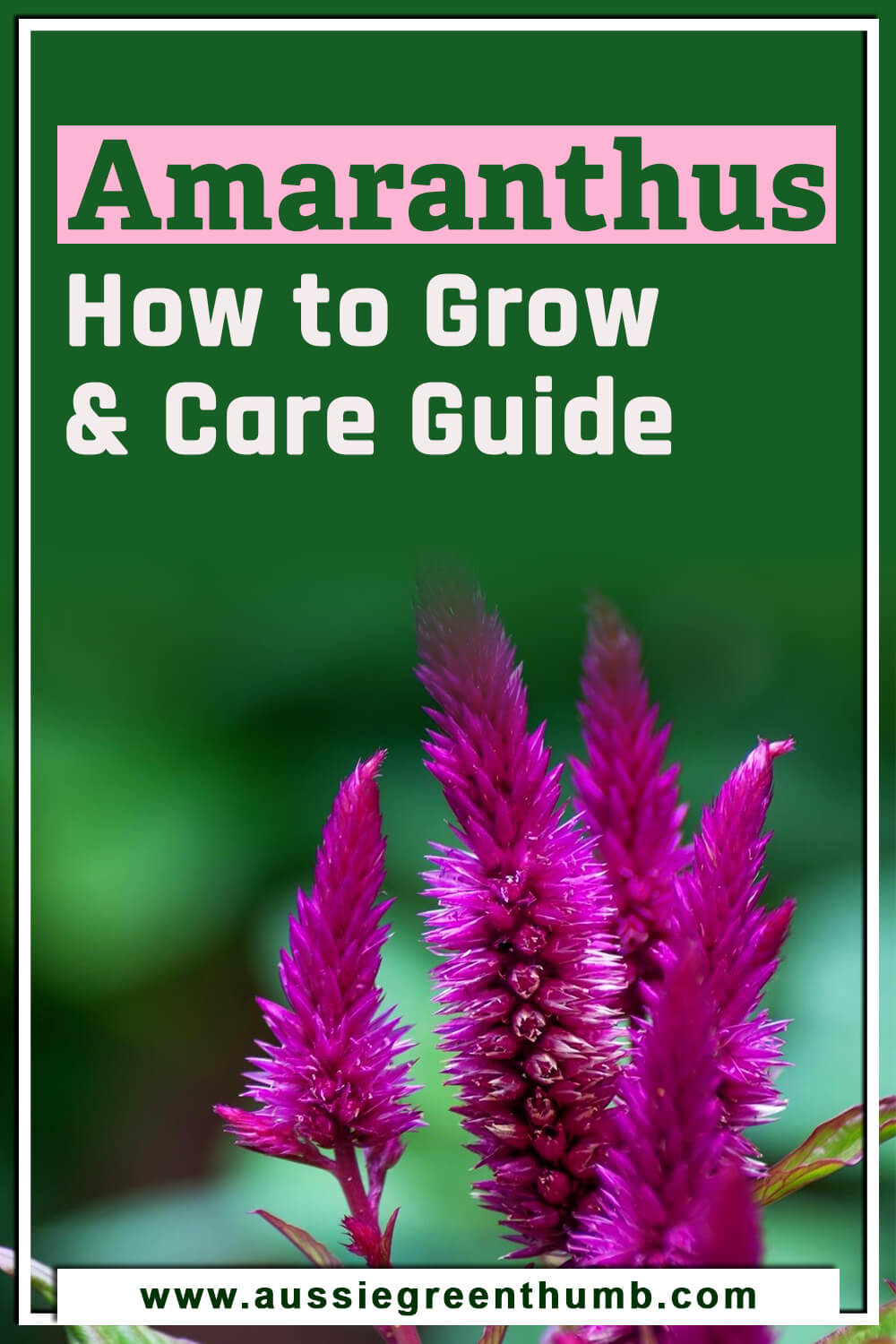
Wrapping Up Our Amaranthus Guide
Amaranthus is a fascinating genus of plants, and one of the rare crop plants that look genuinely incredible in the garden. These American natives grow well in Australian climates, and by following our Amaranthus growing guide above you should get a reliable ornamental plant, along with an exceptionally generous crop.
Published on May 25, 2022 by Maisie Blevins
Last Updated on February 21, 2024




